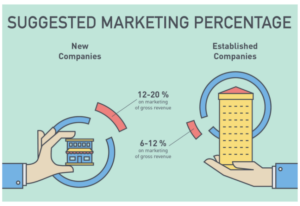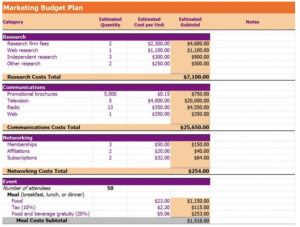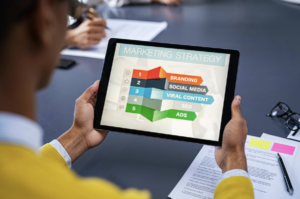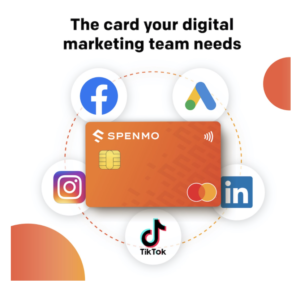The article is a guide to marketing spending for SMEs and how you can utilize virtual cards to optimize this important function of your business.
What is Marketing Spending?
Marketing spending is the amount of money the marketing team spends to promote the brand awareness of the business. Promotional activities include social media, content marketing, paid advertising, SEO, trade shows, and more.
A number of factors to consider when determining your marketing budget are the type of industry, size of business and which growth stage your SME is at. For instance, if your business is just getting started, you may be spending more on marketing to build brand awareness among your consumers.

How Much Should You Be Spending on Marketing? (Source: Nuphoriq)
As a start-up, you want to be on top of your expenses and understand how marketing impacts your overall budgeting. You can get started by thinking about some concrete and measurable ways to determine what worked and what did not – also known as Key Performance Indicators (KPIs) for you to determine the effectiveness of your marketing campaigns.
If you don’t have marketers in place, you as the small business owner would have to get your hands dirty by learning how to develop a marketing budget and we’re here to help you get started with simple marketing spend template:

Marketing budget plan estimates (Source: Microsoft Office Templates)
The rows represent your marketing expense type, and the columns help you to track how many times the particular expense is incurred and how much money is spent on that. A pro-tip to making this template work for you is to update it constantly whenever a marketing spend is incurred, so you don’t have to wait until the end of the month to find out that you’ve overspent or underspent on marketing.
What are the Different Expenses in the Marketing Department?
Once you have your marketing spend template in place, it’d be helpful to develop a pie chart with a percentage indicated for the respective channels to provide you a bird-eye's view of your marketing spending.
Some examples of expenses in the marketing department include, but are not limited to:
- Software: Includes payments for print media platforms used like Adobe, Canva, etc. Also includes subscription rates for marketing automation software which enables businesses to automate their marketing functions including campaign creation, market segmentation, and response analysis.
- Personnel: Includes monthly wages for your sales and marketing team. Also includes expenses incurred outsourcing marketing work to freelancers.
- Advertising: Includes cover ads in print media and online venues, broadcast time, radio time, and direct mail advertising.
- Content Creation: Content varies from blog posts to graphic designs. Includes SEO and digital marketing work, photography and videography, and expenses incurred with engaging a third-party marketing agency to develop advertising campaigns.

Especially for SMEs, digital marketing channels are gaining traction when we speak of marketing spending (Read: Why SMEs Do Better Digital Marketing Than The Biggest Brands, Jan 2021, Forbes). Having an online presence whether through your website or social media is in itself a 24/7 sales machine to reach out to your business. Also, today’s consumers are more empowered and more informed to seek out reviews and information about your product online before the purchasing happens.
What is Zero-Rating Advertising Cost?
A supply of service in Singapore attracts Goods & Services Tax (GST) unless it qualifies for zero-rating relief as an international service under section 21(3) of the GST Act. A list of advertising and related services that qualify for zero-rating provisions is as follows:
Credit score to qualify for the card? Typically requires very good credit. Some cards are available to those with lower credit scores.
| Type of Advertising |
Description of Service |
| Event Organising |
Exhibition or convention services are supplied for:
- Events held overseas
- Events held in Singapore are:
- Contractually supplied to an overseas person wholly in his business capacity; and
- Directly benefiting an overseas person wholly in his business capacity or with effect from 1 Jan 2021, directly benefiting an overseas person wholly in his business capacity and/or a GST-registered local person.
|
| Media planning, creative and production sales, brand PR |
Where services are:
- Contractually supplied to an overseas person; and
- Directly benefiting an overseas person or with effect from 1 Jan 2021, directly benefiting an overseas person and/or a GST-registered local person.
|
|
Media sales supplied
|
- Prior to 1 Jan 2022, where the advertisement is substantially (i.e. more than 51%) circulated overseas;
- On or after 1 Jan 2022, where the services are:
- Contractually supplied to an overseas person; and
- Directly benefiting an overseas person and/or a GST-registered local person.
|
Source: IRAS e-Tax Guide | GST: Guide for Advertising Industry (Third Edition), Jun 2021, Inland Revenue Authority of Singapore
Virtual Cards for Marketing Spend
You want to have control over your budget but at the same time, you don’t want to micromanage your marketing team because they’re the experts here and you trust them with their spending on the business. Virtual cards would be just the solution for you to manage and track your marketing spending.
As many cards, as you want to have, you get to set the budgets on each of them and switch them on and off with only a click! Plus, you can also assign the cards to specific users so a particular person on your team is responsible for managing the card.

While one company credit card being circulated around appears to be the most sensible and easiest to track, there’s a whole lot of work at the end of the month when it comes to reconciling the marketing expenses. Vis-a-vis to using a virtual card for each advertising campaign, each client, or each type of expense.
Before we go on and on, we also want to highlight that every purchase you make through the virtual card(s) is visible from one dashboard, in real-time, and on any internet device you have handy on you. Forget working spreadsheets and data entry throughout the month. You only need to export!
How to Choose the Right Virtual Card for your Marketing Strategy
Virtual cards have practically changed the way banking is being done. There’s a sea of virtual card providers for you to choose from, but you want to spend some time considering the criteria that matter to your business and find one that meets your business needs.
Some key factors to consider when choosing the right virtual card for your marketing strategy include:
- Type of payment card: Single payment like a gift card? Linked to an existing card? Cards with dedicated balances?
- Ease of opening an account: Can it be done online? Or have to do it at a physical banking branch?
- Exchange rates and fees: Currency exchange and other fees need to be laid out in a clear and transparent manner.
- Electronic security: Security measures that the virtual card provider has (e.g. 3-D Security enabled, sufficient security certification which is easily checkable).
- Integration with other services: Ability to connect banking directly to accounting software.
Tips for Tracking your Marketing Spending
Before we go, we want to leave a trail of cookie-crumble tips for SMEs to track your marketing spending:
Tip #1: Track impact on both revenue and leads.
Venture beyond vanity figures like the number of likes, site traffic, and leads generated via your blog! Going back to marketing Return On Investments (ROIs), consider clear metrics that directly tie to your business value like the lead-to-customer ratio, the average cost per lead, and average lead value. Marketing is no cost centre and you want to build a strong business case for your marketing spending.
Tip #2: Review and adapt the strategy.
While planning is important, agility is the name of the game – horizontally across every other industry and vertically across every business function. As you stay true to the values your business stands for, it is also key for your marketing teams to adapt your messages to reflect the realities on the ground to get to your customers.
Tip #3: Pick the right service providers.
Marketing alone has so many aspects – paid advertising, social media, email marketing, content marketing, lead generation, market research/intelligence, etc. Don’t be lazy and opt for a one-stop shop! As it’s been emphasized, invest some time finding the right service providers. Spend a little more time and effort in the look-out, so you make sure the money you spent on marketing will not be a lose-out 😉
